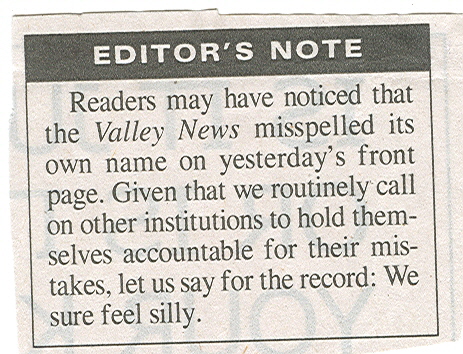
Every day newspapers get filled with the latest information. Every twenty-four hours they are updated and fed to the public, and every day a newspaper will run an apology correcting the mistakes made in previous prints. This system of error and reprint has been around since the beginning of news delivery, yet for the most part it goes unnoticed. A reader does not pick up today's paper wanting to know what was wrong with yesterdays. Any time they spend reading will be to get the quick update on the latest news. Unless a story is ongoing, people may not even remember what they read the day before or question that it may have been inaccurate.
On March 20, 2010 The National Post ran an error correction. In it they apologized for incorrectly saying James Elliott Coyne, a former governor of the Bank of Canada, was dead when in fact he is alive and well. To say someone is dead is a pretty serious accusation and should be checked out carefully before printing such information. Finding out whether someone is still alive should be an extremely easy task, yet it seems to have been overlooked. As a result of such a slip, the reprint ran, but for who's eyes? A small correction is likely to go unnoticed and the damage done by the columnist's error will be solidified.
In an issue of the Sun, a story ran that wrongly described the antics of Nancy Jones at the funeral of her father, Keith Floyd. It described her as being insensitive and having to get escorted out. According to the reprint, Jones was welcomed at the event and was not ushered out because of her behaviour or otherwise. It is incredible that information printed as a fact could be written so wrongly out of proportion. A woman was painted in a very poor light because someone had made his or her own inferences on an event without checking what was real. Not only does this reflect badly on the paper, but also on Nancy Jones. People's reputations can be ruined by what a publication prints about them, whether it's true or not. This should be a thought taken into account every time derogatory stories deride a person's character.
On March 20, 2010 The National Post ran an error correction. In it they apologized for incorrectly saying James Elliott Coyne, a former governor of the Bank of Canada, was dead when in fact he is alive and well. To say someone is dead is a pretty serious accusation and should be checked out carefully before printing such information. Finding out whether someone is still alive should be an extremely easy task, yet it seems to have been overlooked. As a result of such a slip, the reprint ran, but for who's eyes? A small correction is likely to go unnoticed and the damage done by the columnist's error will be solidified.
In an issue of the Sun, a story ran that wrongly described the antics of Nancy Jones at the funeral of her father, Keith Floyd. It described her as being insensitive and having to get escorted out. According to the reprint, Jones was welcomed at the event and was not ushered out because of her behaviour or otherwise. It is incredible that information printed as a fact could be written so wrongly out of proportion. A woman was painted in a very poor light because someone had made his or her own inferences on an event without checking what was real. Not only does this reflect badly on the paper, but also on Nancy Jones. People's reputations can be ruined by what a publication prints about them, whether it's true or not. This should be a thought taken into account every time derogatory stories deride a person's character.
As Jennifer Carbert said in her blog post, "Let each story, caption and picture reflect an attitude of self-respect and honour." Not just honour for those in the story and captions, but honour for the writer. When the time is taken to check the facts, spelling, and grammar there will be much less regrets and far less apologies that go unnoticed.
*note: image from regrettheerror.com

I thoroughly enjoyed your picture in this here blog post, and I think you touched on an issue that is often overlooked. Readers don't really care about the mistakes made in yesterday's paper, they want to read about what is new and often they don't even pay attention to the corrections.
ReplyDeleteObviously that just means that there is more accountability on the part of journalists, copy editors, and news publications to make sure they get the proper information out the first time.
Good stuff.
I think you raise a good point Shannon; often, the first impression of your story is the only one that matters, so corrections are often superfluous, even when published expediently.
ReplyDelete